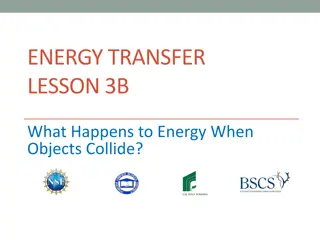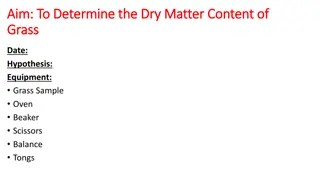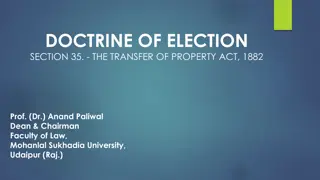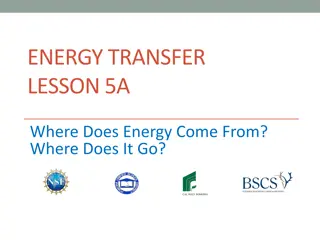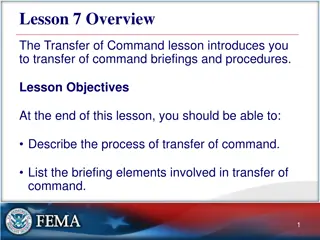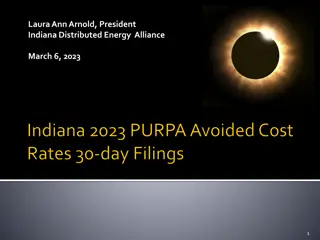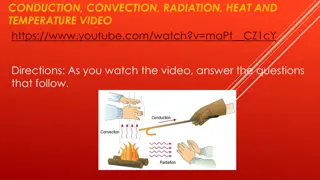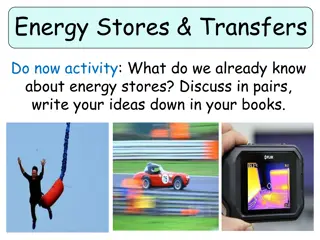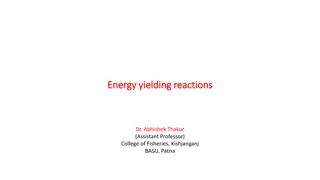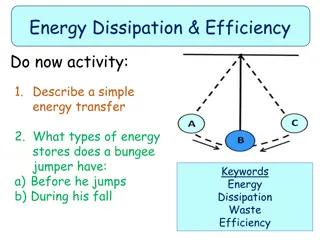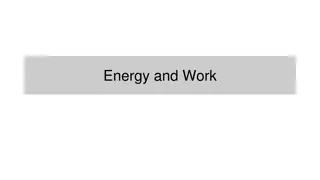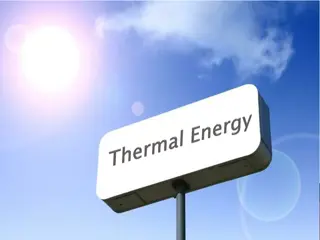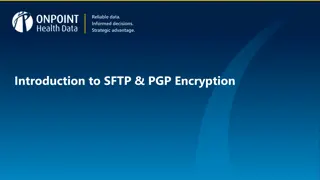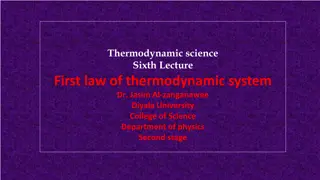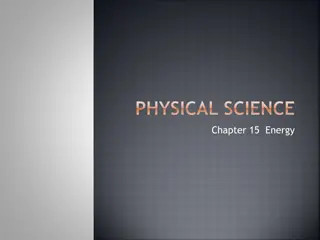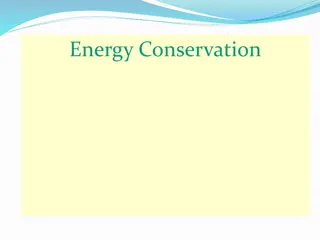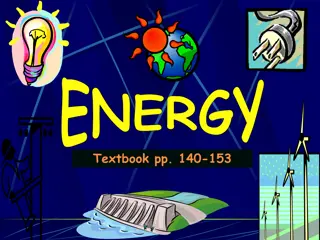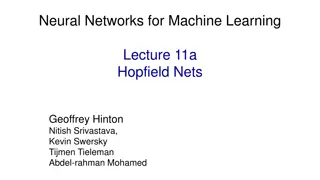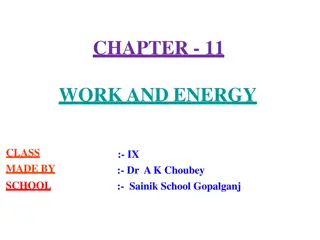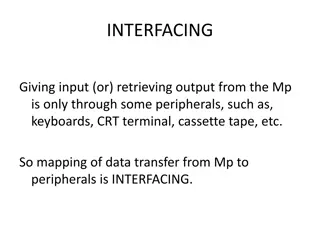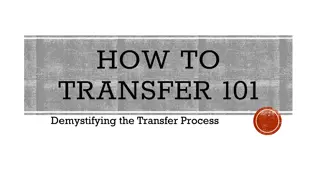Understanding Energy Transfer through Turf vs. Grass Comparison
Students are tasked with analyzing energy transfer properties through modeling and data analysis to explain why artificial turf is hotter and riskier for athletes compared to natural grass. The task aligns with Tennessee Science Standards and Next Generation Science Standards, focusing on energy conservation, mathematical modeling, and argumentation from evidence.
Download Presentation

Please find below an Image/Link to download the presentation.
The content on the website is provided AS IS for your information and personal use only. It may not be sold, licensed, or shared on other websites without obtaining consent from the author. Download presentation by click this link. If you encounter any issues during the download, it is possible that the publisher has removed the file from their server.
E N D
Presentation Transcript
Tennessee District Science Network Task Library Turf vs. Grass Teacher Guide High School Physical Science - Chemistry Three-Dimensional Claim In this task, students are asked to apply an understanding of the quantitative and qualitative properties of energy and energy transfer through modeling, critically reading scientific literature, analyzing data, and constructing an explanation to describe how patterns in data and energy flow can help explain why artificial turf is hotter and more dangerous to athletes than natural grass. Tennessee Academic Standards for Science This task is intended to elicit student learning of the following Tennessee Science Standard: CHEM1.PS3: Draw and interpret heating and cooling curves and phase diagrams. Analyze the energy changes involved in calorimetry by using the law of conservation of energy quantitatively (use of q = mc T) and qualitatively. This standard is not completely measured in this assessment as it is included in multiple units in chemistry. This assessment focuses on specific heat and its relationship to heat transfer. Next Generation Science Standards This task is intended to elicit student learning of the following NGSS elements for each of the three dimensions: Science and Engineering Practices: Developing and Using Models Middle School Element: Develop and/or revise a model to show the relationships among variables, including those that are not observable but predict observable phenomena. Note: This middle school element is used to develop/scaffold skills students may find difficult. Using Mathematics and Computational Thinking High School Element: Use mathematical, computational, and/or algorithmic representations of phenomena or design solutions to describe and/or support claims and/or explanations Engaging in Argument from Evidence High School Element: Construct, use, and/or present an oral and written argument or counter arguments based on data and evidence. Disciplinary Core Ideas PS3.A Definitions of Energy High School Element: Energy is a quantitative property of a system that depends on the motion and interactions of matter and radiation within that system. That there is a single quantity called energy is due to the fact that a system's total energy is conserved, even as, within the system, energy is continually transferred from one object to another and between its various possible forms. Note: The entire DCI is not measured in this assessment. The focus of this assessment is specific heat and its relation to heat transfer. Crosscutting Concepts Patterns High School Element: Mathematical representations are needed to identify some patterns. Energy and Matter: Flows, Cycles, and Conservation High School Element: Changes of energy and matter in a system can be described in terms of energy and matter flows into, out of, and within that system. These materials were developed by the Tennessee District Science Network, a NextGenScience network that included educators six districts in TN, with support from Arconic Foundation. Except where otherwise noted, this work is licensed under the Creative Commons Attribution-NonCommercial 4.0 International License. 1
Tennessee District Science Network Task Library Turf vs. Grass Teacher Guide High School Physical Science - Chemistry Suggestions for Use This is suggested to be a summative assessment. We feel that a holistic grading practice is best; however, we understand the constraints of needing a grade in the gradebook. We suggest giving each Exemplary (EX) answer three points, each Approaching Proficiency (AP) two points, and each Entry Level (EL) one point. We do not feel a straight percentage/total points equates to illustrating the student s proficiency; therefore, we suggest the following scale: Total Points 12/12 9/12 6/12 3/12 1/12 Suggested Percentage 100% 90% 70% 60% 50% Assumptions Teacher has covered kinetic-molecular theory in terms of particle movement related to kinetic energy. This has been represented through particulate diagrams showing energy flow throughout a system. Note: The Disciplinary Core Idea and Cross Cutting Concepts seemingly overlap in this task. Conservation of energy (DCI) in this concept must be understood by analyzing the energy flow into, out of, and within the system (CCC). The teacher will be able to analyze a students answer to determine the student s understanding of the DCI in light of the CCC. Logistics This assessment is expected to take one block class (90 minutes) or two class periods (45 minutes). On question #1, you may need to add a word bank to elicit the kind of scientific language needed for an exemplary ranking. Examples would be: specific heat, conductor, insulator, thermal energy, kinetic energy, temperature, heat transfer. You may need to change the heat equation if you do not use Q=mc T. Question E1, E2, and E3 are enrichment questions for students looking for a challenge or if they finish with excess time. 2
Tennessee District Science Network Task Library Turf vs. Grass Teacher Guide High School Physical Science - Chemistry Intro to Task Many high schools are choosing to replace grass fields with artificial turf fields so players have more even footing all the time and the fields can be used during weather events. However, people have concerns about the consequences of this change. Lots of coaches and players love the benefits of artificial fields. There's no practice time or games lost to muddy conditions, and the fields are easy to maintain. They require no pesticides or water. But increasingly, municipalities are raising questions about extremely high temperatures on the playing fields when the weather is hot and sunny. High Temps on Turf Fields Spark Safety Concerns The first evidence of a "heat island" effect came a few years ago, when Columbia University climate researcher Stuart Gaffin analyzed thermal images generated from NASA satellite maps of New York City. He wanted to figure out how urban trees may help cool down neighborhoods. When Gaffin noticed a bunch of hot spots on the maps, he assumed they were rooftops. But he wanted to know for certain. "So we picked five or six really hot locations in the Bronx and went to visit them, and two turned out to be turf fields" says Gaffin. In retrospect, he says he should have realized that, because they're a perfect sunlight-absorbing system. Temperature Check To understand just how hot the synthetic fields can get, we visited Riverside Park in Manhattan with Geoffrey Croft, founder of NYC Park Advocates. Carrying a thermometer, Croft stood at the periphery of one of the turf fields that's used for a soccer camp. In the shade it's 86 degrees. But out in the center of the soccer field where kids are playing soccer, the sun is directly overhead. Holding his thermometer waist-high, he gets a reading of 160.6 degrees Fahrenheit. Croft is surprised. "It's way higher than I thought it would be," he says. As the coaches call a water break, which they do every 15 minutes or so, a group of 8- and 9-year-olds stands dripping in sweat. "It's hot," says 8-year-old Michael-Luca Natt. "Very hot." Nearby, two more day-campers, Max Rana and Billy Hurwitz, say it can be hard to keep playing when it's so hot on the field. Since crumb-rubber turf absorbs and retains heat, the NYC Health Department report says heat is the primary health concern associated with playing on the fields. It says people can suffer dehydration, heatstroke and thermal burns at field temperatures above 115 degrees. Source: https://www.npr.org/templates/story/story.php?storyId=93364750 3
Tennessee District Science Network Task Library Turf vs. Grass Teacher Guide High School Physical Science - Chemistry Question #1 Task and Rubric Scoring 1. Using scientific evidence and concepts from the article above, energy flow between systems, and your knowledge about energy transfer between matter, construct a paragraph to explain why artificial turf is a hotter surface than natural grass. (You must cite direct quotes/text/data from the article). Rubric Scoring Template This prompt assesses: DCI Energy is a quantitative property of a system that depends on the motion and interactions of matter and radiation within that system. That there is a single quantity called energy is due to the fact that a system's total energy is conserved , even as, within the system, energy is continually transferred from one object to another and between its various possible forms SEP N/A CCC Changes of energy and matter in a system can be described in terms of energy and matter flows into, out of, and within that system. Prompt Scoring Guidance Score Components of Student Response (SEP, CCC, and/or DCI) Example Responses/Look Fors EX -Uses all the relevant evidence from the article to support claim (for example: thermal images generated from NASA satellite maps ) Explains that artificial turf is a better conductor (may mention lower specific heat than grass) than grass thus gaining and losing heat (energy) more quickly than grass to the surrounding air and/or athlete. -May compare to another substance that is a good insulator (has a high specific heat-like H2O). Uses 5 or 6 of the following along with 2 or more citations: specific heat conductor/insulator gaining/losing heat thermal/kinetic energy heat transfers more quickly/slowly temperature AP -May or may not use one statement from the article to support their claim. Mentions that artificial turf is a better conductor of heat than natural grass. Mentions turf releases heat faster than natural grass. Uses 3 or 4 of the list for EX and possibly one citation. EL -Does not use any statements from the article. Mentions turf gets hotter than grass by absorbing more heat or energy. Uses 1 or 2 of the list for EX. 4
Tennessee District Science Network Task Library Turf vs. Grass Teacher Guide High School Physical Science - Chemistry Question #1 continued Rubric Scoring Template, continued Complete Student Response - Example The author gives evidence using thermal images generated from NASA satellite maps to indicate that two turf fields were some of the hottest surfaces recorded from the satellite images. Additionally the article states A Columbia University researcher was skeptical saying "They're spongy and lightweight and that means the solar energy that's absorbed quickly gets converted to high temperatures," This means that the turf has a lower specific heat. A low specific heat means that a substance will change temperature very quickly when heated or cooled Water, by comparison has a very high specific heat and will therefore absorb a lot of heat before changing temperature. Grass, since it is an organism will tend to have a high water content that will keep it cooler than the turf. Score and Score Rationale, if applicable: Exemplary Feedback/Questions to support next level thinking for students: The concern of hotter temperatures on artificial turf seem to be more during the day hours when the sun is out. But what about at night? Would a art. turf field be cooler or hotter during a night game compared to a grass surface? Incomplete Student Response - Example A Score and Score Rationale, if applicable: Approaching Proficiency The author gives evidence using thermal images generated from NASA satellite maps to indicate that two turf fields were some of the hottest surfaces recorded from the satellite images. Since the turf fields are at a higher temperature then they are better conductors of heat and will release the heat faster to the surroundings. Feedback & Next Steps for Students to Make Progress: Good job mentioning conduction/release of heat faster. What does this tell you about turf s specific heat? Why would the grass be a better insulator (what is in grass that would have a high specific heat?) Incomplete Student Response - Example B Score and Score Rationale, if applicable: Entry level Turf is hotter than grass because of specific heat. Feedback & Next Steps for Students to Make Progress: Why does turf absorb/release heat faster? What is specific heat? How does it affect thermal energy? Why would the grass absorb/release heat slower than turf? Score: Example of how you would score that response Scoring Rationale: Reasoning for the score you gave connected to the +1 statements from the scoring guide Feedback for Student: What feedback for the student would you recommend given the example response, with the goal of supporting learning toward missing components in their responses 5
Tennessee District Science Network Task Library Turf vs. Grass Teacher Guide High School Physical Science - Chemistry Question #2 Task and Rubric Scoring 2. Use the data in the graph above to find the specific heat of astroturf and natural grass using the equation Q=mc T (a 1,000 gram sample of astroturf or natural grass produces 36.48 kJ of heat). You must show your work. Next, use the information from your mathematical computations from the graph and the concept of specific heat to write an explanation of why artificial turf is a hotter surface than natural grass. Rubric Scoring Template This prompt assesses: DCI N/A SEP Use mathematical, computational, and/or algorithmic representations of phenomena or design solutions to describe and/or support claims and/or explanations CCC Mathematical representations are needed to identify some patterns. 6
Tennessee District Science Network Task Library Turf vs. Grass Teacher Guide High School Physical Science - Chemistry Question #2 continued Rubric Scoring Template - continued Prompt Scoring Guidance Score Components of Student Response (SEP, CCC, and/or DCI) Example Responses/Look Fors -Determines temperature change from the graph to completes the math correctly using Q=mc T to show that grass has a higher specific heat than artificial turf using the data given (Cgrass=3.6 J/gx C and Cturf=1.9 J/gx C) -Talks about that with a lower specific heat the turf heats up and releases heat more quickly than grass when both are receiving the same amount of heat from the sun. Must do each of the following 3 things: Determines the correct specific heat for both surfaces mathematically Uses his/her math to correctly state that turf has a lower specific heat than grass States that by having a lower specific heat, then a substance will absorb/release heat more quickly than a substance with a higher specific heat EX -Attempts the math but makes a mistake, possibly gets the right answers but fails to explain the reasoning properly or doesn t quite know how to set it up the math correctly. -Does understand and explain that turf heats up more (gets to higher temperatures) than grass and has a lower specific heat than grass. AP Must do 2 of the 3 things listed above in EX. Does not attempt the math. Simply states that the turf got hotter than the grass according to the graph. Attempts the math but gets it wrong and/or simply mentions a temperature difference from the graph. EL Complete Student Response - Example Score and Score Rationale, if applicable: Exemplary The specific heat of the artificial turf is a lower value than the specific heat of the grass. The turf heats up and releases the heat faster. Both the grass and the turf are receiving the same Q (heat from the sun) but the turf gets hotter because it is a better conductor of heat energy (lower specific heat value). Grass Art. Turf Q = m x c x T 36,480J = (1,000g) c (10 C) (1,000g)(10 C) (1,000g)(10 C) (1,000g)(19 C) Cgrass = 3.6 J/g x C Feedback/Questions to support next level thinking for students: Most companies use rubber (c = 2.005 J/gx art. turf to soften the playing surface. Lately, some companies have started to use a rubber/sand (0.780 J/gx ) mixture. What does this possibly do to the heat factor for the turf considering rubber and sand have different specific heats? ) under the Q = m x c x T 36,480J = (1,000g) c (19 C) (1,000g)(19 C) CArt.Turf = 1.9 J/g x C 7
Tennessee District Science Network Task Library Turf vs. Grass Teacher Guide High School Physical Science - Chemistry Question #2 continued Rubric Scoring Template - Continued Incomplete Student Response - Example A Score and Score Rationale, if applicable: Approaching Proficiency (2 point) Grass Art. Turf Q = m x c x (+1) Feedback & Next Steps for Students to Make Progress: T Q = m x c x T Good job setting up the math but take a look at the temperatures in both problems (they can t be the same). 36,480J = (1,000g) c (10 C) (1,000g)(10 C) (1,000g)(10 C) (1,000g)(10 C) Cgrass = 3.6 J/g x C 3.6 J/g x C I m not sure where I messed up the math but I got both having the same specific heat. I know art. turf must have a lower specific heat because it absorbs/releases heat faster than grass. (+1) 36,480J = (1,000g) c (10 C) (1,000g)(19 C) CArt.Turf = Incomplete Student Response - Example B Score and Score Rationale, if applicable: Entry level (1 point) I m not sure how to set up/complete the math but I believe the art. turf will have a lower specific heat because it reached a higher temperature than the grass. (+1) Feedback & Next Steps for Students to Make Progress: You are right that art. turf has a lower specific heat than grass. Math help so you can prove mathematically that art. turf has a lower specific heat: Q is the amount of heat in Joules that is given to you in the problem. m is the mass of each in grams (given to you in the problem). c is the specific heat which is what you will solve for algebraically. T is the temperature change from the beginning and end in the graph. Score: Example of how you would score that response Scoring Rationale: Reasoning for the score you gave connected to the +1 statements from the scoring guide Feedback for Student: What feedback for the student would you recommend given the example response, with the goal of supporting learning toward missing components in their responses 8
Tennessee District Science Network Task Library Turf vs. Grass Teacher Guide High School Physical Science - Chemistry Question #3 Task and Rubric Scoring 3. Many athletes suffer from dehydration and cramps more often on artificial turf than on natural grass. Complete the model below by matching the given particle diagrams in the correct step/box to show how the heat transfer happens. Using your knowledge of heat transfer and your completed model for the system, explain why an athlete would dehydrate more quickly playing on artificial turf versus natural grass. Use the key below The green dots represent turf or grass particles. The red dots represent the particles in the athlete s body. The wide blue arrow represents energy transfer between grass/turf and athlete. The green and red arrows represent the movement of particles; the longer the arrow, the more movement of particles. 9
Tennessee District Science Network Task Library Turf vs. Grass Teacher Guide High School Physical Science Chemistry Question #3 continued Rubric Scoring Template This prompt assesses: Energy is a quantitative property of a system that depends on the motion and interactions of matter and radiation within that system. That there is a single quantity called energy is due to the fact that a system's total energy is conserved , even as, within the system, energy is continually transferred from one object to another and between its various possible forms. DCI Develop and/or revise a model to show the relationships among variables, including those that are not observable but predict observable phenomena. *SEP Changes of energy and matter in a system can be described in terms of energy and matter flows into, out of, and within that system. CCC Prompt Scoring Guidance Sco re Components of Student Response (SEP, CCC, and/or DCI) Example Responses/Look Fors EX Students can match the particle diagrams in the correct order. Students indicate that turf has a lower specific heat capacity than grass meaning it takes less heat to change the temperature of the turf. Heat energy will transfer to the athlete through conduction and radiation causing the athlete to sweat. Sweating is a cooling mechanism: evaporation of water from the body or system to the air (surroundings)[transfer of heat from system to surroundings] Radiation from the sun may be shown to indicate the transfer of heat to the turf or grass. (It is not necessary for students to indicate this transfer to earn full credit) In box A Students should match # 1 to the top graphic and # 5 to the bottom graphic. In box B students should match # 6 to the top graphic and # 2 to the bottom graphic and in box C , students should match # 3 to the top graphic and # 4 to the bottom graphic. Turf has a lower heat capacity (It takes less energy to increase 1 gram of a substance 1 degree Celsius) so given the same amount of energy and mass, turf will increase in temperature faster than grass (higher heat capacity.) Heat transfers to the athlete via conduction and radiation. Sweat is a cooling process because heat is leaving the system since sweat evaporates it absorbs the heat from the athlete and transfers it to the surroundings (air.) 10
Tennessee District Science Network Task Library Turf vs. Grass Teacher Guide High School Physical Science Chemistry Question #3 continued Prompt Scoring Guidance Score Components of Student Response (SEP, CCC, and/or DCI) Example Responses/Look Fors AP Students match 4-5 of the 6 diagrams correctly. Students indicate turf has a lower specific heat but fail to explain what that means OR students explain specific heat capacity with errors. Students indicate that heat energy from the turn will transfer to the athlete. Students indicate that athlete s will be hotter or will sweat, but do not explicitly indicate that evaporation of the sweat causing the athlete to cool. In box A Students should match # 1 to the top graphic and # 5 to the bottom graphic. In box B students should match # 6 to the top graphic and # 2 to the bottom graphic and in box C , students should match # 3 to the top graphic and # 4 to the bottom graphic. Turf has a lower (smaller) specific heat capacity than grass. The athlete s body will sweat more with increased heat from the Turf. EL Students are unable to match more than 3 diagrams correctly. Students mentions specific heat capacity but does not indicate if turf has a higher or lower specific heat capacity, nor the effect it will have on the turf vs grass. Students indicate that heat transfer or the athlete temperature increases causing the athlete to sweat. In box A Students should match # 1 to the top graphic and # 5 to the bottom graphic. In box B students should match # 6 to the top graphic and # 2 to the bottom graphic and in box C , students should match # 3 to the top graphic and # 4 to the bottom graphic. Turf and grass have different heat capacities. The athlete gets hotter and sweats more. Complete Student Response - Example When playing on a turf field as compared to a grass field, the low specific heat of the turf will cause it to rise to a higher temperature than the grass. The athlete will absorb this additional heat (as compared to grass)from the surface of the turf through conduction and radiation causing the athlete to sweat more since the body is trying to regulate its body temperature. Sweating can cause the athlete to lose increased amounts of fluid causing dehydration to occur more quickly. Sweating is a cooling process as heat is transferred from the athlete to the surroundings as the sweat evaporates from the athlete s body. Score and Score Rationale, if applicable: Exemplary Feedback/Questions to support next level thinking for students: How is evaporation causing the body to cool? Think in terms of the system and the surroundings. 11
Tennessee District Science Network Task Library Turf vs. Grass Teacher Guide High School Physical Science Chemistry Question #3 continued Rubric Scoring Template - Continued Score and Score Rationale, if applicable: Approaching Proficient Incomplete Student Response - Example A An athlete will dehydrate more quickly on turf because it gets much hotter while grass tends to stay cooler. The high heat of the turf due to its lower heat capacity causes the body to sweat more releasing more water to stay cool. Since the grass stays cooler, the body doesn t have to sweat so much to keep it cool. Feedback & Next Steps for Students to Make Progress: What does it mean to have a lower specific heat capacity? What happens when the body sweats? Incomplete Student Response - Example B On artificial turf, an athlete would dehydrate faster because the heat from the turn would transfer to the body heating it up as well. Score and Score Rationale, if applicable: Entry Level Feedback & Next Steps for Students to Make Progress: Why would the heat transfer faster to the athlete on turf? What is different about the turf than the grass? Score: Example of how you would score that response Scoring Rationale: Reasoning for the score you gave connected to the +1 statements from the scoring guide Feedback for Student: What feedback for the student would you recommend given the example response, with the goal of supporting learning toward missing components in their responses 12
Tennessee District Science Network Task Library Turf vs. Grass Teacher Guide High School Physical Science - Chemistry Question #4 Brainstorming You will be constructing an argument to convince your school to either use natural grass or artificial turf as the playing surface for your football field. In an effort to make sure that your argument contains the criteria and constraints of each field design, you have the opportunity to brainstorm with a team of students. Be sure to include information from the text (cite quotations), graph, calculations, model, and prior knowledge. Record your findings in the graphic organizer below. Use the checklist to make sure that you have included information from each part of this assignment. This area will not be graded. We have included information from each of the following: Text/Article (Question 1) Graph (Question 2) Calculations (Question 2) Model (Question 3) Prior Knowledge of Group Member 13
Tennessee District Science Network Task Library Turf vs. Grass Teacher Guide High School Physical Science Chemistry Question #4 continued 4. Your school is trying to decide whether to install an artificial turf field to replace the natural grass. You must persuade your school as to which surface they should use for their field. You have two options for the format of your persuasive presentation: Option 1 - Persuasive Commercial: You will create an oral argument in the form of a 30-60 second commercial that will be broadcast locally to the members of your community. Your commercial should make a scientifically based claim as to which field will be best for your school. Your claim must be based on data and supported by evidence from the text/article, graph, calculations, model and prior knowledge. You must also identify reasons why the advantages of one type of field outweigh the advantages of another. Because this commercial will be broadcast to a large audience, it needs to be presented by video (e.g., flipgrid) and presented in a way that catches the attention of the public and is fun and exciting. This task is to be completed in a group of three to four individuals. Option 2 - Persuasive Letter: You will create a written argument in the form of a persuasive letter to the superintendent of your district, your principal, and the head football coach. Your letter should make a scientifically based claim as to which field will be best for your school. Your claim must be based on data and supported by evidence from the text/article, graph, calculations, model and prior knowledge. You must also identify reasons why the advantages of one type of field outweigh the advantages of another. You must use a professional style of writing as this letter is to be written to school officials. This task is to be completed individually. 14
Tennessee District Science Network Task Library Turf vs. Grass Teacher Guide High School Physical Science Chemistry Question #4 continued This prompt assesses: DCI Energy is a quantitative property of a system that depends on the motion and interactions of matter and radiation within that system. That there is a single quantity called energy is due to the fact that a system's total energy is conserved , even as, within the system, energy is continually transferred from one object to another and between its various possible forms. SEP Construct, use, and/or present an oral and written argument or counter-arguments based on data and evidence. CCC N/A. Prompt Scoring Guidance Score Components of Student Response (SEP, CCC, DCI) Example Responses/Look Fors EX Student creates an argument (written or oral) which is based on data and cites evidence from prompts throughout the task. Student completes 5 of 6 of the following. Statement choosing turf or grass as the playing surface. Connection of the temperature of the playing surfaces to specific heat. Uses the graph to compare temperatures of turf and grass. Correctly identifies the specific heats of turf and grass and explains/compares the temperature change of turf and grass based on the specific heat. Explains the heat transfer from playing surface to player and compares turf and grass in terms of heat transfer. Cites reason(s) from article that are not listed above. AP Student creates an argument (written or oral) which is somewhat based on data and cites evidence from prompts throughout the task. Students complete 3-4 of 6 (see above) EL Student creates an argument (written or oral) which is very loosely (or not at all) based on data and cites evidence from prompts throughout the task. Students complete 0-2 of 6 (see above) 15
Tennessee District Science Network Task Library Turf vs. Grass Teacher Guide High School Physical Science - Chemistry Question #4 continued Complete Student Response - Example Dear Dr. Smith, Dr. Jackson, and Coach Blank, I would recommend using natural grass as the surface for our football field. As you may be well aware, artificial turf gets much hotter than natural grass. As one study found, In the shade it's 86 degrees. But out in the center of the soccer field where kids are playing soccer, the sun is directly overhead. Holding his thermometer waist-high, he gets a reading of 160.6 degrees Fahrenheit (High Temps on Turf Fields Spark Safety Concerns). In another study, natural grass s temperature increased by 10 C over a four-hour period, while astroturf increased twice that in the same four-hour period. These increases in temperature are no fluke; it is based in a scientific principle called specific heat. From the data presented in the graph, I was able to calculate the specific heat of grass as being 3.6 J/gC and astroturf at 1.9 J/gC. Basically, specific heat is the amount of energy it takes to heat a substance. Because astroturf has a much lower specific heat, this means that it will heat up faster. This heat is then transferred directly to the player s body. This can cause cramping, dehydration and heat exhaustion. I have had personal experience with this when I got rug burns from sliding on the field. I realize that astroturf is less expensive to maintain, due to having to cut, water, and paint grass; however, I believe that the grass is better for the athlete and is, therefore, better for our school. Score and Score Rationale, if applicable: Exemplary Feedback/Questions to support next level thinking for students: Great job! This is thoroughly explained with so much evidence! Incomplete Student Response - Example A I would recommend natural grass. I would recommend this because it gives off less heat and is safer than the artificial turf would be. It gives off less heat because it does not get as hot over time as seen in the graph. This means that it has a lower specific heat. Using natural grass would not cause so many heat strokes and dehydration due to it emitting less heat. Although it has many benefits, natural grass has its downsides like the upkeep of the grass and mud from when it rains. Score and Score Rationale, if applicable: Approaching Proficiency Feedback & Next Steps for Students to Make Progress: You have made a claim and supported it by evidence, which is great. Your argument could have been even stronger if you would have gone into more detail about specific heat. What is specific heat? Why does it make the grass cooler? What is the specific heat of grass? Astroturf? Incomplete Student Response - Example B Grass fields are better. They are cooler. I think they are softer. Score and Score Rationale, if applicable: Entry Level Feedback & Next Steps for Students to Make Progress: You have made a scientific claim, which is great. You just need to support it with evidence. Was there anything in the article that could have done this? What role did specific heat make in your decision to go with grass? These materials were developed by the Tennessee District Science Network, a NextGenScience network that included educators six districts in TN, with support from Arconic Foundation. Except where otherwise noted, this work is licensed under the Creative Commons Attribution-NonCommercial 4.0 International License. 16




